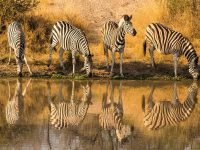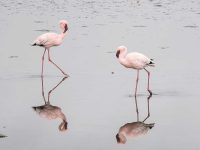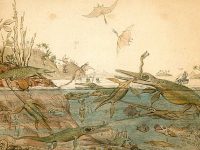
From the simplest of cells to the first bands of hominids treading on two legs across the African savannah, the history of life in this planet is based on cooperation. Life emerged around 4,000 million years ago, in the surface of a desolate planet violently bombarded by meteorites, shattered by continuous volcanic eruptions, and covered by an atmosphere of toxic gases. In one of those first pools and oceans that peppered this Dantesque world took place the most important event of our galaxy, perhaps of the whole universe: the first molecules capable of replicating themselves appeared. With them, natural selection ensued, from so simple a beginning, relentlessly purging generation after generation of replicators to select those better able to multiply and colonize this then – almost – inhospitable planet. The rest is pre-history.
Biologists recognize several «major evolutionary transitions», each of which gave rise to an explosion of new ways of life and a qualitative leap on the scale of biological complexity. The union of individual replicators within a cell constitutes one of the first and more important major transitions, and would give rise to prokaryotic cells (e.g. bacteria). The advent of the first eukaryotic cell, with a true nucleus, is another of these major transitions, resulting from the symbiosis between two different types of prokaryotic cells; the mitochondria in each of our cells, the power station that fuels all cell metabolic processes, are descendants of the bacteria that took part in this fusion. Other major transitions include the first multicellular organisms, arising from the union of different eukaryotic cells, mutualism, arising from the union of different multicellular organisms, or animal societies, arising from the close cooperation between different individuals of the same species. All these evolutionary transitions rest crucially on the cooperation between entities at a given scale of biological complexity to form an individual or collective at a different scale of complexity. How can we explain such widespread cooperation, generating such extraordinary diversity of biological forms and functions, in a world that is otherwise dominated by competition?
«We are cooperative organisms evolved in a world of ruthless competition»
There is no short answer to this question, which actually occupies one of the most important disciplines within Evolutionary Biology: Social Evolution. In essence, though, we classify major transitions into two main types. On the one hand, we talk of «egalitarian» transitions when organisms cooperate among themselves because it is in their mutual benefit to do so; simply because cooperation leads to better survival and/or more reproduction. These types of transitions are ripe with conflicts of interests, whereby each organism strives to exploit the other to their own advantage, and the way evolution tends to resolve such conflicts is by favouring obligate dependencies so that one organisms cannot survive and/or reproduce without the other. «Fraternal transitions», on the other hand, are driven by common interests between organisms that are related to each other, and hence share a significant proportion of their genes. In these cases, it can be in the best evolutionary interest of one individual (e.g., a mother) to sacrifice itself for the benefit of related individuals (e.g., its offspring), simply because it is the most effective way of passing along its genes. The latter phenomenon, termed kin selection, is probably responsible for multicellularity and much (if not most) of the seemingly altruistic behaviour observed in nature, such as the alarm calls that Vervet monkeys use to warn their group members against predators or cooperative breeding in birds and mammals.
In a nutshell, cooperation is one of the most widespread and successful adaptations ever to result from natural selection, a process otherwise based on raw competition for survival and reproduction. To it we owe more than perhaps any other species in this planet. We are colonial multicellular organisms formed by eukaryotic cells, our bodies teeming with bacterial symbionts, and we live in the most complex animal societies nature has ever witnessed. We are the result of a complex evolutionary sequence of symbiosis and cooperative interactions that span thousands of millions of years, at all the different levels of biological complexity, from the first replicators to the formation of an inter-dependent community of 7000 million humans interspersed around the globe. Let us not forget it, we are cooperative organisms evolved in a world of ruthless competition.





